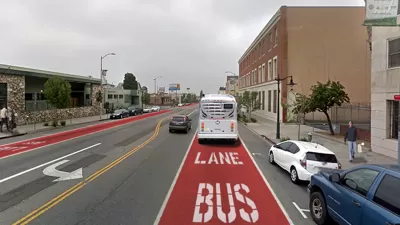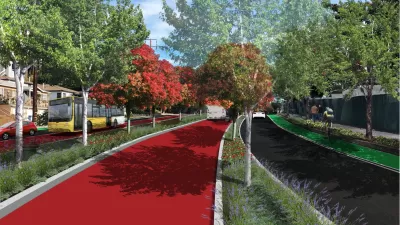To celebrate an important victory a winning team sometimes parades around the arena with their coach on their shoulders as the fans cheer in adulation. Planners sometimes deserve similar treatment! For example, regardless of who wins the 2010 FIFA World Cup to be held in South Africa June and July 2010, the real victor will be residents of the four cities where matches will be held, who gain an efficient new public transportation system as a long-term legacy. Everybody wins!
To celebrate an important victory a winning team sometimes parades around the arena with their coach on their shoulders as the fans cheer in adulation. Planners sometimes deserve similar treatment! For example, regardless of who wins the 2010 FIFA World Cup to be held in South Africa June and July 2010, the real victor will be residents of the four cities where matches will be held, who gain an efficient new public transportation system as a long-term legacy. Everybody wins!
The Rea Vaya ("We are Moving") Bus Rapid Transit (BRT) system began operation last month with service between Johannesburg and the Soweto township. This is a significant milestone in the development of high quality, affordable transport in Africa. Rea Vaya is the continent's first full BRT system. Although it has its share of initial teething problems, the results are fantastic. Users are delighted with Rea Vaya.
Rea Vaya can help change transportaiton trends in Africa.
This first route currently averages a respectable 12,000 to 16,000 daily passengers, and even off-peak runs are often crowded. Ridership is expected to increase substantially as the network expands and incorporates features such as express service that further reduces travel times. The Port Elizabeth and Cape Town systems will also be operating soon. The Tshwane (Pretoria) system was delayed but construction is about to begin.

Rea Vaya uses high capacity buses on their own right-of-way with comfortable and secure stations.
It is difficult to convey the magnitude of this accomplishment. Previously, low-income commuters were forced to use crowded, dangerous, unreliable and costly private minivans, called taxis. In contrast, the new BRT systems offer world-class service. Spacious vehicles provide fast and reliable transport from early morning until late at night. Stations are clean and bright, and employees treat passengers with respect. Other African cities now have an example to follow.
The project faced huge obstacles, including complex political dynamics. In particular, the taxi industry, known for violence, opposes the project, fearing job losses. Their fears are actually misplaced, former taxi drivers are being integrated into the BRT system as bus operators where they have better working conditions, more job security and more opportunities for advancement. There are still conflicts, the first day of Rea Vaya operation somebody (assumedly taxi drivers) shot at one of the buses, injuring two passengers, but service has continued with no subsequent attacks. Security teams are visible throughout the system, and it is safer than the existing minibuses, which have frequent crashes and incidences of violence. BRT cannot serve every route so there will continue to be a role for the private operators, but they will need to improve their service quality to stay competitive.
This project will help inspire more sustainable transportation throughout Africa. Because existing public transport service is poor, residents tend to purchase a car and abandon the public transport system as soon as they can, despite large direct and indirect costs. As a result, traffic is congested, traffic fatality rates are high, and these countries devote a large and growing portion of their wealth to importing vehicles and fuel, displacing investments that can improve productivity and provide badly needed services such as medical care.
This project has special meaning to many of us who care about progress and equity in lower-income regions. Years ago the Soweto township was a center of anti-apartheid resistance, including an uprising and government massacre in 1976. Fortunately, South Africa has progressed since. It is now multi-racial and developing rapidly, but still greatly burdened by a legacy of physical segregation and underdevelopment of Black African communities. These communities desperately need respect, security and economic opportunity. BRT provides tangible progress for township residents. This is an example when basic infrastructure improvements provide many layers of benefit.
I am proud of having made a small contribution to this project. I visited South Africa in 2006 and gave presentations to planners and public officials on transport policy innovations. The star of the tour was Lloyd Wright of Viva Cities, a tireless advocate of sustainable transportation who literally wrote the book on BRT planning. He convinced the mayors of the four major cities that BRT was the only practical way that South Africa could provide efficient mobility during the 2010 World Cup. Lloyd spent much of the last two years in South Africa working to keep the projects on track. The result of his efforts will be much more than just a well-run soccer match; these projects will leave a lasting legacy of betterment.
A soccer team's success depends on good coaching: thoughtful, methodical, tedious background work and countless well-made decisions which create the environment in which individual players can perform efficiently. That sounds a lot like good planning. The many people working now to implement BRT in South Africa are true planning heroes!
For more information:
BRT Resources Website (www.sutp.org/newweb/brt/brtress.htm) maintained by the Sustainable Urban Transport Project, provides a variety of BRT planning guides and other resources.
CalTrans (2007), Bus Rapid Transit: A Handbook for Partners, California Department of Transportation (www.dot.ca.gov); at www.dot.ca.gov/hq/MassTrans/DOCS_PDFS/BRT/BRT_Handbook_0307.pdf.
Cape Town Integrated Rapid Transit Website (www.capetown.gov.za/en/irt/Pages/default.aspx).
Kittleson & Associates (2007), Bus Rapid Transit Practitioner's Guide, Report 118, Transit Cooperative Research Program, TRB (www.trb.org); at http://onlinepubs.trb.org/onlinepubs/tcrp/tcrp_rpt_118.pdf.
Rea Vaya Website (www.reavaya.org.za) and Facebook Page (www.facebook.com/pages/Rea-Vaya-BRT-Johannesburg/26984412309)
Rea Vaya: We Are Going!, Success Story, Institute of Transportation and Development Policy (www.itdp.org/index.php/projects/update/rea_vaya_we_are_going).
Rea Vaya Facebook Page (http://www.facebook.com/search/?q=Rea+Vaya&init=quick#/album.php?aid=103249&id=97180389844)
Tom Rickert (2006), Bus Rapid Transit Accessibility Guidelines, World Bank (www.worldbank.org); at www.gobrt.org/AccessibilityWB.pdf.
Erica Schlaikjer (2009), "Rea Vaya On the Move in Joburg, South Africa," The City Fix (http://thecityfix.com/rea-vaya-on-the-move-in-joburg-south-africa)
Lloyd Wright (2006), "Bus Rapid Transit," module in the Sustainable Transport: A Sourcebook for Policy-makers in Developing Cities, published by the Sustainable Urban Transport Project – Asia (www.sutp-asia.org), Deutsche Gesellschaft fur Technische Zusammenarbeit (www.gtz.de), and the Institute of Transportation and Development Policy (www.itdp.org).
Lloyd Wright (2007), Bus Rapid Transit Planning Guide, Institute for Transportation and Development Policy (www.itdp.org); at www.itdp.org/index.php/microsite/brt_planning_guide.

Maui's Vacation Rental Debate Turns Ugly
Verbal attacks, misinformation campaigns and fistfights plague a high-stakes debate to convert thousands of vacation rentals into long-term housing.

Planetizen Federal Action Tracker
A weekly monitor of how Trump’s orders and actions are impacting planners and planning in America.

San Francisco Suspends Traffic Calming Amidst Record Deaths
Citing “a challenging fiscal landscape,” the city will cease the program on the heels of 42 traffic deaths, including 24 pedestrians.

Defunct Pittsburgh Power Plant to Become Residential Tower
A decommissioned steam heat plant will be redeveloped into almost 100 affordable housing units.

Trump Prompts Restructuring of Transportation Research Board in “Unprecedented Overreach”
The TRB has eliminated more than half of its committees including those focused on climate, equity, and cities.

Amtrak Rolls Out New Orleans to Alabama “Mardi Gras” Train
The new service will operate morning and evening departures between Mobile and New Orleans.
Urban Design for Planners 1: Software Tools
This six-course series explores essential urban design concepts using open source software and equips planners with the tools they need to participate fully in the urban design process.
Planning for Universal Design
Learn the tools for implementing Universal Design in planning regulations.
Heyer Gruel & Associates PA
JM Goldson LLC
Custer County Colorado
City of Camden Redevelopment Agency
City of Astoria
Transportation Research & Education Center (TREC) at Portland State University
Jefferson Parish Government
Camden Redevelopment Agency
City of Claremont






























